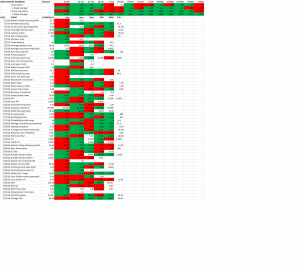UP & DOWN WALL STREET
Dow was up 0.66% and the SP500 up 1.22% for the week. There appears to be some slight deescalation in hot spots around the world as a ceasefire held between Israel and Hamas and US airstrike relieved pressure between ISIS and Kurdistan.
George Friedman of Stratfor sees 10 plus years of “Lebanonization” of the middle east. In other words, civil wars that will tear apart countries that were artificially created back in 1916. This will likely translate into rocky financial markets. Friedman thinks Putin might be tossed out at leader of Russia at some future point not that far away.
REVIEW
Germany’s economy declined and 10-year bunds fell below 1%. Output in Japan fell 6.8%. Wal Mart reduced its guidance on earnings. Store traffic declines for the 7th straight quarter. Carl Icahn said “We are in a major asset bubble that continues to grow.”
SOME COMPANIES THAT BARRON’S WROTE ABOUT THIS WEEK
Andrew Bary’s article says that the recent financial engineering by Kinder Morgan (KMI) makes the Company overpriced. Jack Hough writes about four companies that are “ready for a rebound”, they are BBT, COP, JNPR and UTX. Jonathan Buck’s article on TNTE.Netherlands says the stock can continue to decline. David Englander says ABM can increase by 15% over the next year. The cover story is on the positive prospects for SLB.
AN INTERVIEW WITH STEPHEN AUTH
Auth thinks the market can increase 30% over the next 18 months.
The Trader
Dow advances 0.7% and the SP500 advances 1.2% to 1955.06. Industrial production rose and job openings increased. Retail sales up only 0.1% below expectations and the economy contracted in Germany and Italy by 0.2% each in Q2. Earnings reports are improved by 10.2% over last year. About 59% of stocks have beaten earnings estimates and 61% have beaten revenue estimates.

